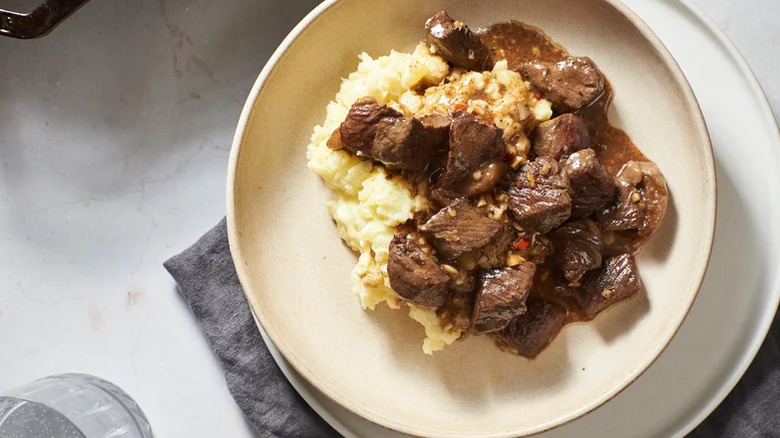The 2 Best Cuts Of Meat To Use When Making Steak Tips
Bite-sized and snackable, steak tips are beloved for their rich beefy flavor and tender mouthfeel. They're the perfect choice for when you're craving a protein-packed meal but don't want to cook (or eat) an entire slab of beef — or, for that matter, splurge on a pricey cut. You see, steak tips are a delicacy born of economy; they're the answer to making the most of the more undesirable, and therefore affordable, parts of a cow. And in order to nail their signature taste and texture, the cut you choose is of utmost importance.
According to Michael Taus, chef at La Grande Boucherie in Chicago, flap steak and tri-tip are your two best options for making a meal of steak tips. As he told Tasting Table, "Both cuts are flavorful, tender when cooked properly, and more affordable than premium cuts. Their balance of marbling and texture makes them ideal for quick, high-heat cooking."
Both tri-tip and flap steak are cut from the bottom part of a sirloin, an area of lesser-used muscles. Tri-tip, a particularly popular pick among carnivores in West Coast locales like like California, is named so as it is a triangular muscle cut from an area near the hide. Flap steak, which we consider a worthy alternative to tri-tip, is obtained from the nearby lower flank. That cut is preferred on the east coast, especially in New England, where steak tips are considered a regional specialty. (See our recipe for New England-style steak tips here.)
Why tougher cuts make for better steak tips
Tri-tip and flap steak are both leaner than higher-end cuts. While that may make them unsuitable for other sorts of steak presentations, the very nature of making steak tips solves any problems those bottom-sirloin cuts present. Those chopped bites of beef are characterized by their robust flavor, which not only comes courtesy of the meat itself, but also by way of a marinade and high-heat sear. Cuts like tri-tip and flap steak are a good fit for multiple reasons.
First, they're well-suited for marinades. These cuts also have long, loose grains that make it easier for the meat to really soak up the flavor. Secondly, as Michael Taus said, these cuts are particularly equipped for high-heat searing, the cooking method of choice for steak tips. This is what helps the cubed pieces develop a browned crust on the outside, adding some smokiness and depth to their overall profile. You can do this on a grill or on your stovetop, preferably in a super hot cast iron pan.

